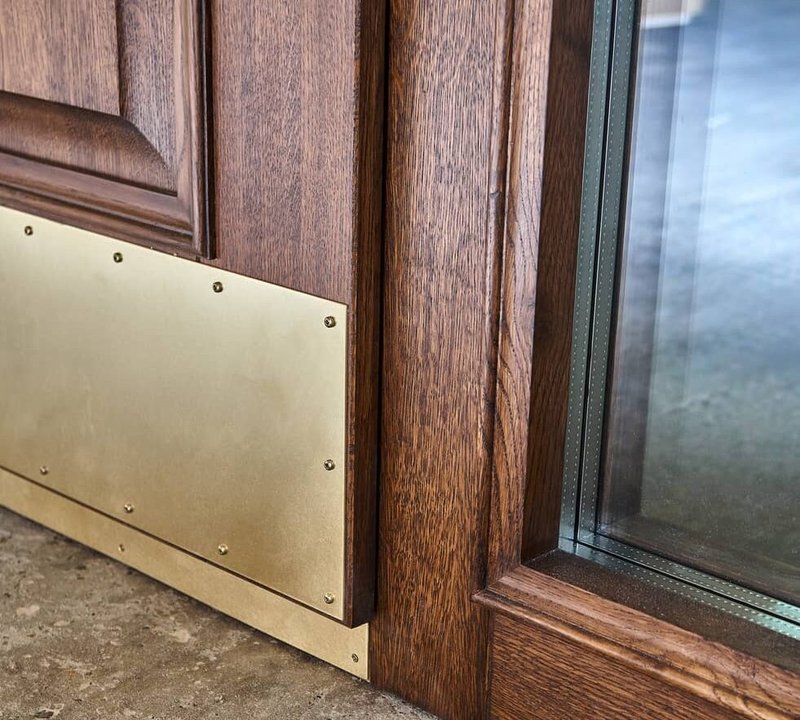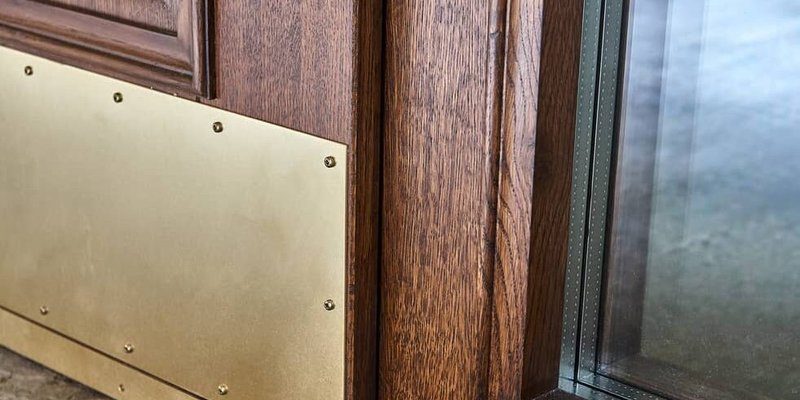
Honestly, you don’t need to be a pro (or even especially handy) to fix up a nickel-brushed, brass, or stainless steel kick plate with dents or pits. The process is much less intimidating than it seems at first glance. You’ll just need a handful of common tools, a little patience, and a couple of easy tricks—think more pet-scratch removal than full-on auto body repair.
Why Do Kick Plates Get Dents and Pits?
Let’s face it: kick plates live rough lives. They sit at the bottom of doors—right where shoes scuff, pets dig, kids bash toys, and movers forget to lift. Over time, even tough metals like stainless steel, aluminum, or brass will pick up small dents or pits.
Here’s the thing: metals are tough, but not invincible. Brass is softer, so it nicks and scratches more easily. Stainless steel resists rust and stains, but it can get dinged by a pointy shoe or a runaway vacuum cleaner. Even anodized aluminum—supposedly dent-resistant—will eventually show signs of daily life. Pits are a bit different from dents; they’re usually caused by corrosion, sometimes from cleaning chemicals or salty air, especially on exterior doors.
The good news is, these little battle scars are mostly cosmetic. But if you leave corrosion to fester, pits can get deeper, and small dents can eventually turn into unsightly war wounds. So, if you catch them early, you’ll keep your kick plate looking fresh much longer.
Tools and Materials for Kick Plate Repair
Before you start hammering or sanding away, it’s smart to gather everything you’ll need. Most small dents or pits in kick plates can be fixed with just a few simple tools—nothing fancier than what you’d use for a bike or a kitchen drawer.
- Rubber mallet or small hammer (with a cloth to cushion blows for delicate finishes)
- Wood block (to back up the kick plate and avoid more dents)
- Automotive body filler (for deeper pits or stubborn dents)
- Sandpaper (start with 220 grit, then finer for polishing)
- Metal polish or finishing cream (to blend your repair)
- Screwdriver (to remove the kick plate if needed, usually Phillips head)
- Microfiber cloth (for cleaning and polishing)
You might be wondering if you need to buy everything—nope. Most dents can be fixed with a mallet, a cloth, and a little polish. Only stubborn pits or deeper dents call for filler and sanding.
Step-by-Step: Fixing Small Dents in a Kick Plate
Let me explain how to actually get those dents out. Here’s the real-world, keep-it-simple version:
- Remove the kick plate (optional): It’s easier to work on a flat surface, but you can fix most dents with the plate still attached. If you’re dealing with more than one dent or need to use filler, pull out a screwdriver and pop the plate off gently.
- Cushion the work area: Place the plate on a folded towel or old t-shirt. This helps prevent new scratches while you’re working.
- Use the mallet and wood block: Set the wood block behind the dent (on the opposite side if removed, or press from behind if the plate’s off the door). Lightly tap the dent with the mallet, checking your progress as you go. The idea is to nudge the metal back into shape, not to flatten it with brute force.
- Finish with sandpaper (if needed): For stubborn high spots, use a small bit of 220 grit sandpaper and move in light, circular motions. If your finish is brushed or satin, follow its grain to blend the repair.
- Polish for shine: Wipe away any residue, then use a little metal polish to restore luster and blend the fixed spot with the rest of the kick plate.
If you’re a perfectionist, don’t expect the fix to be invisible—unless you’ve got pro-grade bodywork skills. But honestly, you’ll be amazed at how tidy a quick repair can look.
Dealing With Small Pits and Corrosion
Pits aren’t dents—they’re tiny holes or craters, often from corrosion. They’re tougher to fix because you can’t really “push” metal back in. But you can fill them, blend, and polish so they’re much less noticeable.
Small pits are like the freckles of a kick plate—mostly harmless, but they can multiply if ignored.
Here’s your repair plan:
- Clean the entire plate with soap and water to remove dirt, then dry thoroughly.
- Use a small dab of automotive body filler in each pit. Let it dry according to the packaging.
- Sand smooth using 220 grit, then finer grit sandpaper. Follow the direction of the metal’s finish.
- Wipe everything down and use a dab of metal polish to blend the patch. Satin finishes are more forgiving than mirror-polished brass, so don’t stress the small stuff.
If you catch corrosion early, plain metal polish might be enough to erase shallow pits. Deeper craters really do need filler, or they’ll only get worse with time.
Can You Prevent Dents or Pits in a Kick Plate?
Here’s the eternal question—can you actually stop your kick plate from getting dinged in the first place? In a word: mostly, but not entirely. Kick plates by brands like Schlage, National Hardware, or Don-Jo are built to be tough, but daily wear is inevitable unless you put up a “please don’t kick” sign (and nobody wants that).
You can get ahead of the worst damage, though:
- Wipe down your kick plate often. Dirt and salt can speed up corrosion, especially on brass or aluminum. A quick weekly clean makes a big difference.
- Avoid harsh cleaners. Bleach and ammonia break down finishes and cause pitting.
- Stick felt pads on the bottoms of heavy boots, dollies, or strollers that go in and out often.
If your door sees a lot of pet action, you can even train pets to use a different “dog door” instead of pawing at brass kick plates. Not always realistic—but hey, it helps!
How Kick Plate Material Affects Repairs
You might be thinking, “Does it matter if my kick plate is stainless, brass, or aluminum?” The answer is yes—each material has its quirks.
- Stainless steel: Holds up well, but dents can be a pain to pop out due to the hardness. Use a rubber mallet, not a metal hammer.
- Brass: Softer, easy to dent, and polishes up nicely. Watch out for scratches when sanding or blending.
- Anodized aluminum: Light and dent-resistant, but once it pits, the finish is tricky to repair. Go gentle with filler and only sand lightly.
Whatever the finish, the “tap from behind” trick works best. Polishing afterward makes your repair less obvious. If you want a perfect match, stick to plain satin or brushed finishes rather than high-gloss or intricately patterned plates.
When to Replace Instead of Repairing a Kick Plate
Let’s be honest: sometimes, a kick plate is too far gone for a quick fix. If yours looks like it’s been through a hailstorm or if the pits are deep craters, replacement is probably a smarter move.
Most hardware stores carry door kick plates in standard sizes and finishes, whether you need polished brass, oil-rubbed bronze, or brushed stainless steel. Swapping one out usually just takes a screwdriver and a few minutes. Universal plates fit most doors, but if you’re working with a branded setup—like Schlage or Don-Jo—check for any special mounting holes or features before ordering.
If the cost is a concern, repairing is almost always cheaper. But if you want that crisp, new-door look, replacement might be the way to go. Just save your old screws, especially if they’re color-matched!
Closing Thoughts: Keeping Your Kick Plate Looking Good
Repairing a kick plate that’s developed small dents or pits isn’t rocket science—it’s more like patching a favorite pair of jeans. With a little attention, the right tools, and a patient approach, you’ll keep your door looking sharp and tidy for years to come. Sure, it might never be 100% flawless, but honestly, most people won’t notice a thing once you’ve smoothed out those dings. And if you need to sync up your repair routine with other metal fixtures or troubleshooting around the house, you’ll find these skills come in handy all over.
Whether your kick plate is brushed nickel, classic brass, or tough stainless steel, a bit of regular TLC does wonders. So, don’t let small dents or pits bug you—they’re signs of a life well-lived, but you don’t have to live with them forever.
